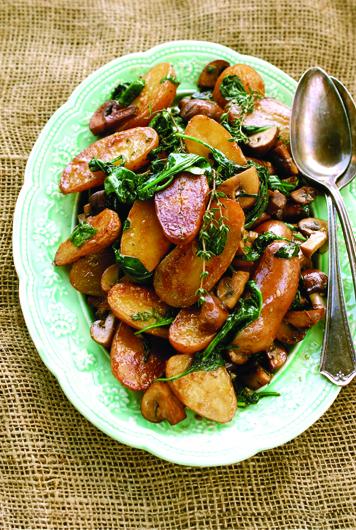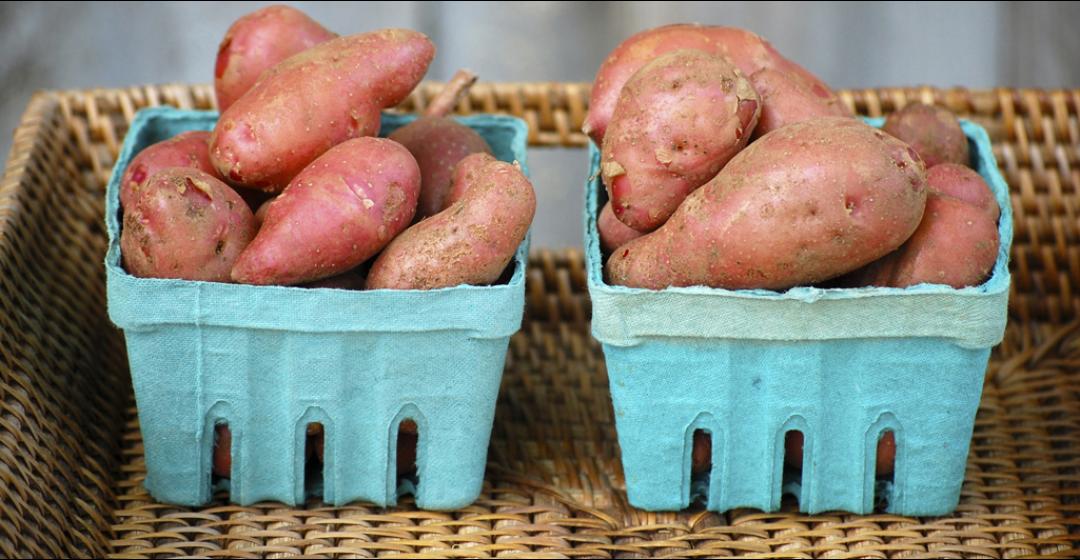French fingerlings – say that fast five times. I mean, who wouldn’t want to eat a potato that sounds so frolicky and flirtatious? Not that any potato really needs a P.R. campaign. But there is a certain mystique surrounding the lovely fingerling, so I am here to part the curtains and reveal the secrets of this charming tuber.
A fingerling is a type (not a variety) of potato, defined by its slender (often knobby) shape, relatively small size, and thin skin that doesn’t need to be peeled. The skin and flesh of many fingerlings boast lovely hues, and fingerlings are famously flavorful.
What most cooks don’t realize is that within the fingerling designation, the different varieties have different cooking qualities. And that is mostly due to varying starch content. In my experience, a Russian Banana fingerling, a Purple Peruvian fingerling, or a Red Thumb fingerling will cook up rather dry if roasted to a fare-thee-well. These varieties have a good bit of starch and a floury texture similar to baking potatoes. On the other hand, French fingerlings (the variety we grow the most of on Green Island Farm), are less starchy and have a creamier, firmer texture more like a Yukon Gold. They can be cooked just about any way you want, and they withstand the dry heat of oven roasting much better than other varieties.
Yet it seems that most cooking sources insist that roasting is the hands-down best method for all fingerlings. As much as I love roasting, I disagree. I think that the best method for cooking a fingerling, no matter what the variety, is a combination of dry and wet heat – a technique I call brown-braising. By browning the fingerlings in a skillet first, then simmering in broth to finish, you’ll still get that golden caramelized flavor, but the potatoes will have a pleasing texture, too. (Follow the recipe to learn this easy stovetop technique.)
It’s good to know you can brown-braise any variety of fingerling, in case you can’t find French fingerlings (sometimes also called Roseval). They certainly sell out fast at our farm stand. One chap recently knocked on the back door of our house looking for some. We recognized him as the frequent fingerling shopper, but had to politely ask him not to detour from the farm stand to our house! And no, we weren’t hiding any anywhere. The funny thing is (and I probably shouldn’t tell you this), I’m pretty sure I’ve found French fingerlings in the grocery store after some poking around. Green Giant’s “Klondike gourmet” potatoes include a “red-skinned, yellow-fleshed” potato that looks awfully familiar. Yeah, they’re not freshly dug from Martha’s Vineyard soil, but they’ll do when a craving arises.

Next year you can try growing some of your own fingerlings. A couple pounds of seeds planted in late spring will get you twenty-five or thirty pounds of potatoes in late summer and early fall. The fun thing about growing your own is that you get all different sizes; some look more like toes than fingers, and others are the size of a fist. But all are delicious.
And yes, you can go ahead and roast them. Just douse them in a nice bath of olive oil, include some moist aromatics like onions or shallots, pack them a bit snugly into the pan so that a combination of steaming and roasting occurs, and don’t overcook them. And did I mention they’re great grilled, too? Oh honestly, I could fill an entire cookbook with fingerling recipes. Hmm….
Recipe for Fingerling Potato, Cremini Mushroom, and Baby Spinach Ragout with Lemon-Thyme Butter







